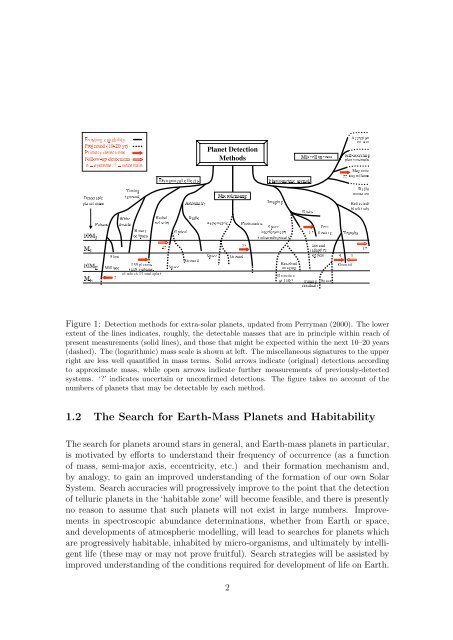Report - School of Physics
Report - School of Physics
Report - School of Physics
Create successful ePaper yourself
Turn your PDF publications into a flip-book with our unique Google optimized e-Paper software.
Figure 1: Detection methods for extra-solar planets, updated from Perryman (2000). The lower<br />
extent <strong>of</strong> the lines indicates, roughly, the detectable masses that are in principle within reach <strong>of</strong><br />
present measurements (solid lines), and those that might be expected within the next 10–20 years<br />
(dashed). The (logarithmic) mass scale is shown at left. The miscellaneous signatures to the upper<br />
right are less well quantified in mass terms. Solid arrows indicate (original) detections according<br />
to approximate mass, while open arrows indicate further measurements <strong>of</strong> previously-detected<br />
systems. ‘?’ indicates uncertain or unconfirmed detections. The figure takes no account <strong>of</strong> the<br />
numbers <strong>of</strong> planets that may be detectable by each method.<br />
1.2 The Search for Earth-Mass Planets and Habitability<br />
The search for planets around stars in general, and Earth-mass planets in particular,<br />
is motivated by efforts to understand their frequency <strong>of</strong> occurrence (as a function<br />
<strong>of</strong> mass, semi-major axis, eccentricity, etc.) and their formation mechanism and,<br />
by analogy, to gain an improved understanding <strong>of</strong> the formation <strong>of</strong> our own Solar<br />
System. Search accuracies will progressively improve to the point that the detection<br />
<strong>of</strong> telluric planets in the ‘habitable zone’ will become feasible, and there is presently<br />
no reason to assume that such planets will not exist in large numbers. Improvements<br />
in spectroscopic abundance determinations, whether from Earth or space,<br />
and developments <strong>of</strong> atmospheric modelling, will lead to searches for planets which<br />
are progressively habitable, inhabited by micro-organisms, and ultimately by intelligent<br />
life (these may or may not prove fruitful). Search strategies will be assisted by<br />
improved understanding <strong>of</strong> the conditions required for development <strong>of</strong> life on Earth.<br />
2
















